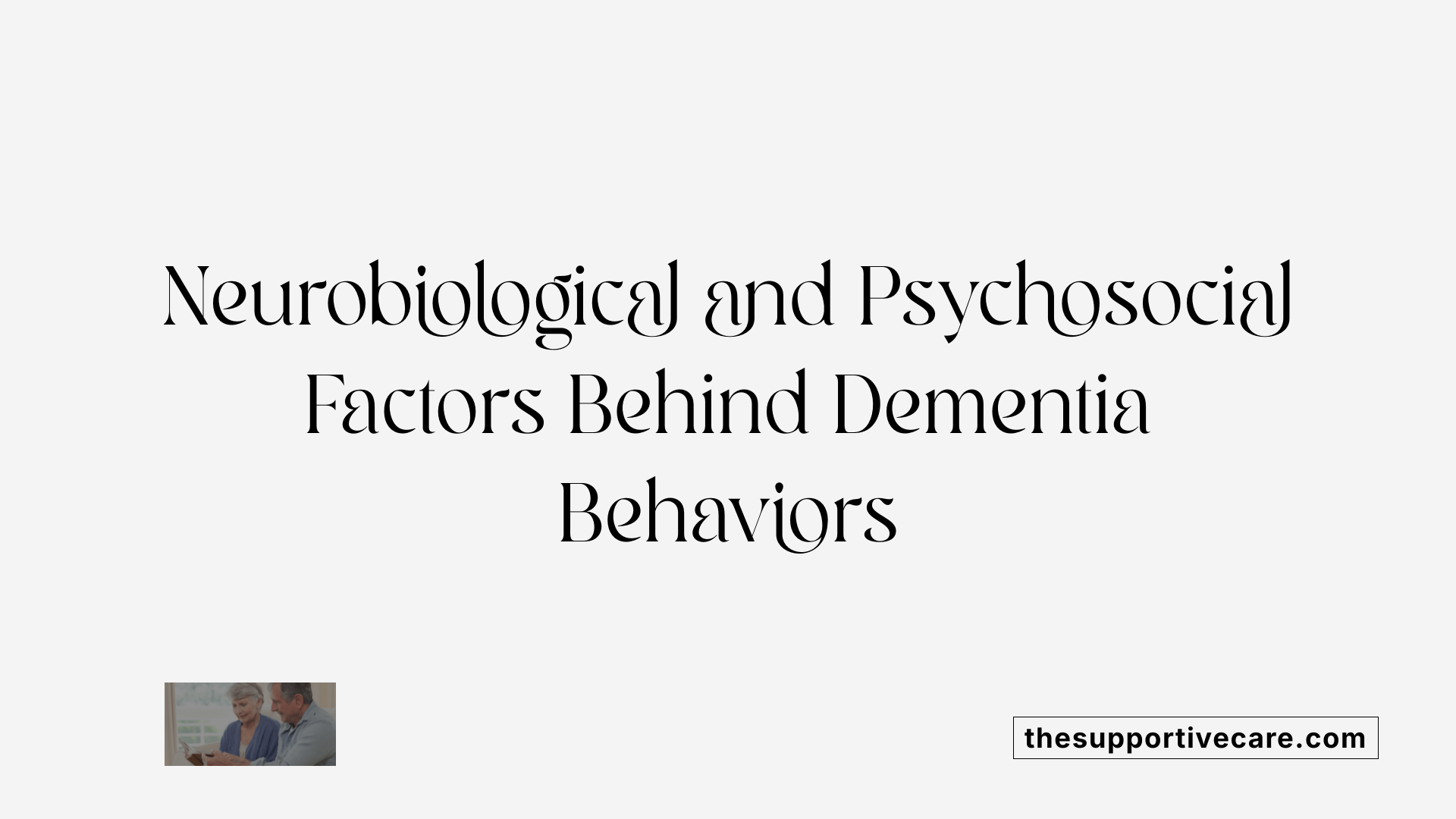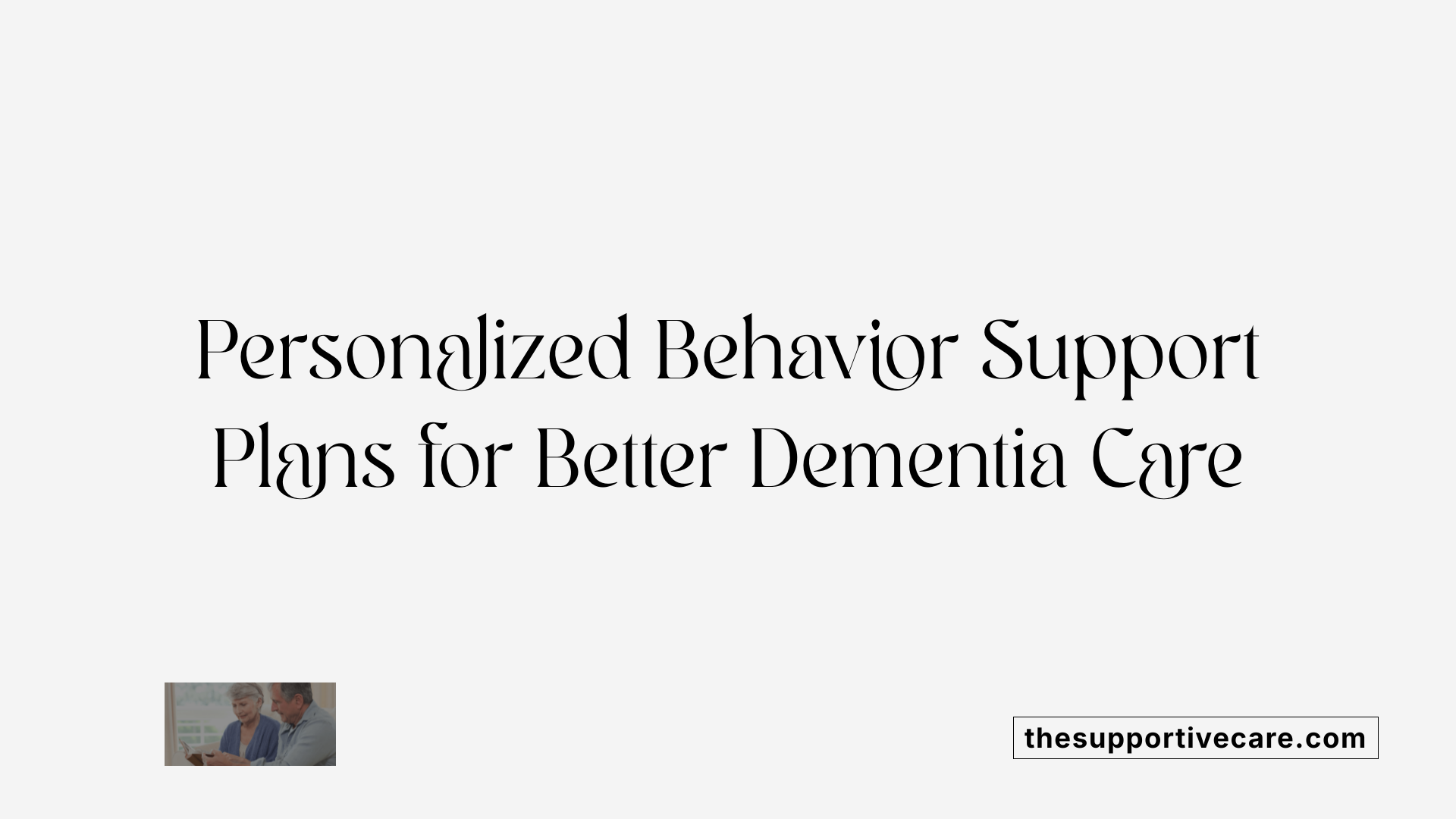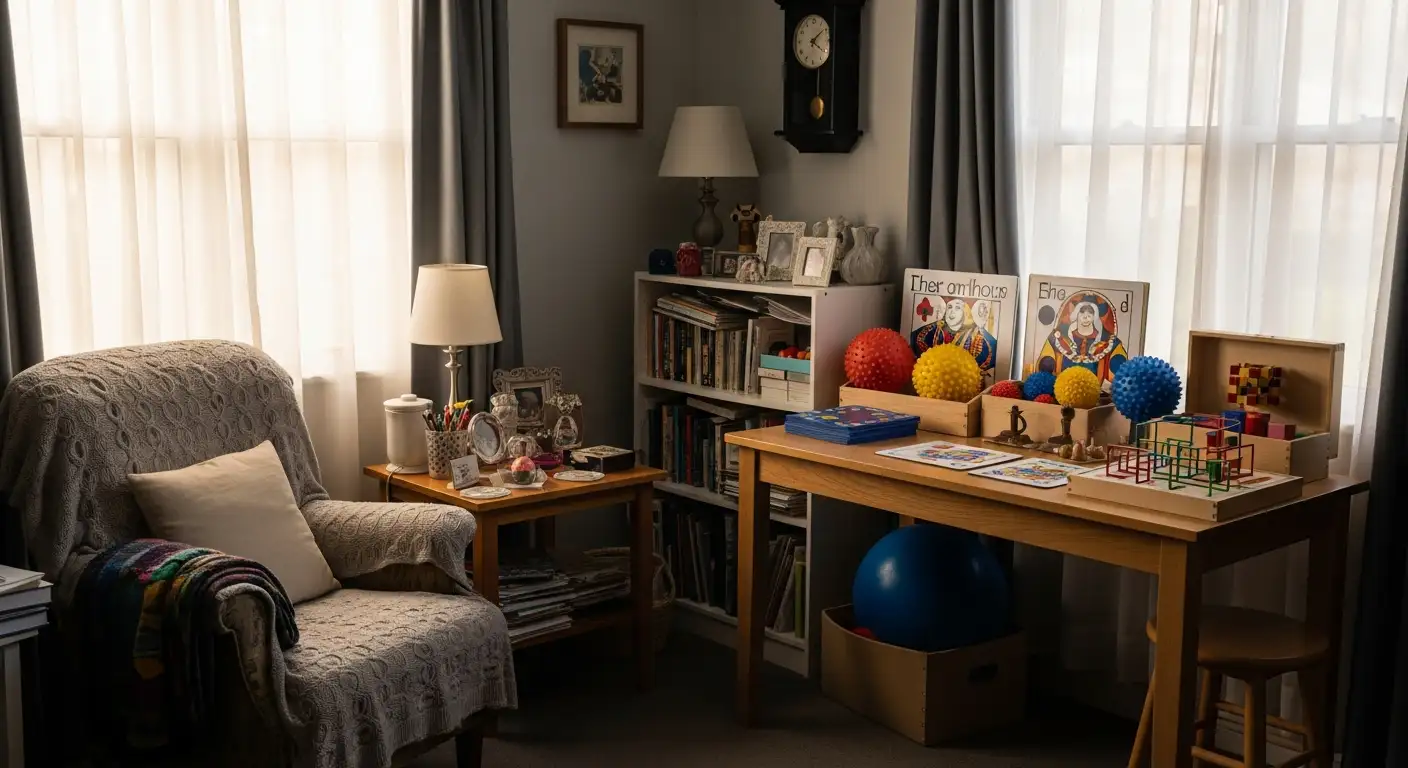Understanding and Addressing Behavioral Challenges in Dementia Care
Managing behavioral and psychological symptoms of dementia (BPSD) requires a comprehensive, person-centered approach tailored to each individual's needs. Recognizing the presentation, causes, and effective management strategies of BPSD is fundamental to developing an effective behavioral management plan for dementia patients. This article explores practical methods, evidence-based frameworks, caregiver training, environmental modifications, and innovative models guiding dementia care, emphasizing non-pharmacological interventions, safety, and caregiver well-being.
The Nature of Behavioral and Psychological Symptoms in Dementia

How do behavioral and psychological symptoms of dementia (BPSD) typically present and what causes them?
Behavioral and psychological symptoms of dementia (BPSD) manifest in various ways. Patients may experience disturbances in their emotional states, such as depression, anxiety, agitation, and apathy. They can also display abnormal thought processes, including delusions and hallucinations. Perceptual disturbances and motor behaviors are common, with behaviors like wandering, aggression, and restlessness. Sleep and appetite changes are also frequently observed.
These symptoms often occur together and can fluctuate over time. They are frequently triggered or worsened by environmental circumstances, unmet physical or emotional needs, discomfort, or the progression of the disease itself. The underlying causes of BPSD are complex and multifaceted.
Neurobiological factors play a significant role. Structural brain changes, particularly atrophy in areas responsible for emotional regulation, contribute to these behaviors. Neurochemical imbalances, including deficits in neurotransmitters like acetylcholine, serotonin, and dopamine, also influence symptom expression.
Psychosocial factors, such as environmental overstimulation or deprivation, further impact the manifestation of BPSD. The heterogeneity and unpredictability of symptoms reflect the intricate interplay between neurodegeneration and psychosocial elements.
Overall, BPSD are extremely common, affecting up to 90% of individuals with dementia. They diminish quality of life for patients, increase caregiver stress, and challenge healthcare management. Recognizing the presentation and understanding the causes are essential steps toward effective, compassionate management.
Identifying Triggers and Causes of Challenging Behaviors
What are common behavioral challenges faced by dementia caregivers during nighttime?
Nighttime can be particularly challenging for caregivers of people with dementia. Common issues include wandering, agitation, aggression, and sleep disturbances such as trouble falling or staying asleep. These behaviors often arise from a combination of physiological and environmental factors.
One major trigger is sundowning, a phenomenon where confusion and agitation worsen as evening approaches. Pain or discomfort, unmet needs, or unfamiliar environments can also provoke such behaviors. Changes in lighting, noise levels, or routines might increase confusion or restlessness.
Patients may act disoriented about day and night—often believing it is daytime when it is actually night—leading to increased activity and difficulty settling down. Hallucinations, increased anxiety, and paranoia are other issues that may surface during nighttime.
Managing these behaviors involves several strategies. Establishing consistent routines helps create predictability, reducing anxiety. Keeping the environment calm and well-lit can diminish confusion and agitation. Using familiar objects, maintaining a regular sleep schedule, and avoiding overstimulation are also beneficial.
Furthermore, addressing caregivers’ mental health is crucial. Feelings of stress, depression, or anxiety can impair their response to challenging behaviors. Support through education and community resources can empower caregivers, helping them respond more effectively and reducing their own stress levels.
In summary, understanding the triggers of nighttime behaviors—such as sundowning, discomfort, or environmental changes—and applying targeted interventions can significantly improve outcomes for both patients and caregivers.
Non-Pharmacological Interventions and Environmental Strategies

How can non-pharmacological strategies help manage dementia-related behaviors?
Non-pharmacological approaches play a crucial role in managing behavioral and psychological symptoms of dementia (BPSD). By creating a calming, supportive environment, these strategies address common triggers such as confusion, overstimulation, or unmet needs. For example, maintaining a routine helps leverage procedural memory, fostering a sense of stability and purpose.
Effective communication techniques are essential, including speaking slowly, using simple language, and reassuring the individual. These methods help in reducing paranoia, hallucinations, and agitation by providing comfort and clarity.
Physical and recreational activities, such as walking, music therapy, and simple exercises, can improve mood, reduce anxiety, and promote better sleep. Additionally, modifications at home—like removing trip hazards, installing safety locks, and ensuring proper lighting—enhance safety and independence.
Overall, these strategies help reduce distress, prevent harmful behaviors, and uphold the person's dignity. They foster a sense of security, promote engagement, and support quality of life for individuals with dementia.
What environmental modifications are effective in dementia care?
Creating a safe and soothing environment is fundamental in dementia care. Effective modifications include avoiding sensory deprivation, which can heighten confusion or distress, and preventing overstimulation by controlling noise levels and visual clutter.
Safety measures are vital, such as removing hazardous items, installing locks on doors or cabinets, and using alarms or sensors to prevent wandering. Adequate lighting—especially during evening hours—is crucial to reduce sundowning symptoms, where individuals experience increased confusion or agitation as daylight fades.
Limiting visual stimuli that may provoke reactions—like busy patterns or reflective surfaces—helps maintain calmness. Designating safe areas where individuals can pace or walk freely encourages physical activity without risk.
Incorporating these environmental strategies reduces stressors and environmental triggers, creating a more comfortable, predictable space that supports emotional well-being and minimizes problematic behaviors.
Developing Care and Behavior Support Plans

What is a behavior support plan for dementia patients?
A behavior support plan (BSP) for dementia patients is a personalized document designed to understand, manage, and improve problematic behaviors. It serves as a structured approach for caregivers and care teams, focusing on individual needs and preferences.
The development of a BSP is now a legal requirement for aged care providers, ensuring that each resident’s unique behavioral challenges are addressed through tailored strategies. This plan begins with thorough assessment—identifying triggers such as environmental factors, unmet needs, or physical discomfort—and then creating interventions suited to the individual.
Strategies outlined in a BSP often include environmental modifications—for instance, reducing overstimulation or improving lighting during evening hours—as well as communication techniques like simple, reassuring language or nonverbal cues. Engagement activities such as music therapy or routine-based interventions are also incorporated.
Crucially, the BSP promotes viewing behavior as a form of communication, helping caregivers recognize early signals of distress or unmet needs. This understanding guides appropriate responses, from distraction and reassurance to environmental adjustments.
Ongoing assessment and documentation are fundamental to the BSP’s success. Regular reviews allow adaptations in response to changing behaviors or health status. Support tools and templates are available to assist providers in creating compliant, person-centered support plans that respect the dignity and individuality of each person with dementia.
By implementing comprehensive, dynamic BSPs, caregivers can reduce agitation, enhance quality of life, and foster a respectful, supportive environment for those living with dementia.
Caregiver Education and Training in Behavior Management
Providing effective education and training for caregivers is essential to manage behavioral and psychological symptoms of dementia (BPSD) effectively. Best practices focus on equipping caregivers with skills to handle complex behaviors, ensure safety, and promote the individual's dignity.
Skill-building in communication is fundamental. Caregivers should learn techniques such as speaking slowly, using simple instructions, and validating emotions instead of correcting or reasoning. Non-verbal cues, reassurance, and familiar objects can foster calm interactions and reduce frustration.
Environmental management involves training caregivers to create a supportive setting. This includes maintaining adequate lighting, minimizing overstimulation, and removing hazards to prevent falls or wandering. Recognizing environmental triggers of problematic behaviors helps in modifying surroundings to promote safety and comfort.
Safety and emergency procedures are vital components. Caregivers need to understand how to implement safety measures such as door locks, alarms, and identification tools to prevent wandering. They should also be prepared for emergencies like falls or health crises, knowing when and how to seek medical help.
Effective training combines education on the disease process with practical applications. Caregivers learn to observe behaviors, assess possible causes such as pain, dehydration, or medication side effects, and employ nonpharmacological strategies like distraction, routine establishment, and emotional reassurance.
Supporting caregiver well-being is also emphasized. Stress management techniques, access to support groups, and planning for future healthcare decisions help sustain the caregiver's capacity for compassionate care.
In summary, comprehensive caregiver training combines communication skills, environmental adaptations, safety protocols, and emotional support to improve the quality of life for both persons with dementia and their caregivers.
Frameworks and Models for Practical Implementation
What are effective behavioral management strategies for dementia patients?
Managing challenging behaviors in dementia requires a combination of non-pharmacological techniques and structured frameworks that guide caregivers and healthcare professionals. These include establishing consistent routines, modifying the environment to reduce overstimulation or deprivation, and using personalized communication approaches like reassurance and simple instructions. Understanding the individual’s history, preferences, and triggers is fundamental.
Two notable models that facilitate this approach are the GUIDE Model and the 6 R's framework.
The GUIDE Model is a comprehensive care approach launched by CMS, aiming to improve quality of life for people with dementia while supporting their unpaid caregivers. It emphasizes care coordination, caregiver education, respite services, and a standardized method including 24/7 support access, multidisciplinary teams, and community linkages. The model focuses on consistency, early intervention, and addressing social needs.
The 6 R's—Restrict, Reassess, Reconsider, Rechannel, Reassure, Review—are practical steps that can be used to manage behaviors. They help caregivers respond with patience and flexibility. For example, if a person becomes agitated, caregivers might Reassure and Rechannel the energy into a different activity, then Review what triggered the behavior for future planning. This approach encourages a person-centered and adaptive response to changing behaviors.
Behavior support plans (BSPs) are essential tools that outline individualized strategies tailored to each person's needs. These plans document triggers, preferred activities, environmental adjustments, and communication techniques. Developing a BSP involves careful assessment, ongoing evaluation, and collaboration among caregivers, residents, and healthcare professionals. It turns challenging behaviors into opportunities for understanding and connection, ultimately promoting dignity and safety.
Incorporating these frameworks into daily care helps create a calm, safe, and respectful environment that supports the well-being of people with dementia. They also empower caregivers through structured guidance, reducing stress and improving the quality of care.
Pharmacological Considerations in BPSD Management
Medications play an important, but often cautious, role in managing behavioral symptoms associated with dementia, particularly when non-pharmacological interventions are not enough or when behaviors cause significant distress or safety concerns.
The primary goal of medication use in BPSD is to reduce agitation, psychosis, depression, and sleep disturbances, thereby improving quality of life for the patient. Commonly, antidepressants such as citalopram or trazodone are employed to treat depression and anxiety. Cholinesterase inhibitors (like donepezil and rivastigmine) and memantine are also used, not only to slow cognitive decline but also to mitigate symptoms such as anxiety.
In cases of severe agitation or psychosis, atypical antipsychotics like risperidone and olanzapine might be considered. FDA-approved drugs like brexpiprazole have also gained approval for specific symptoms in dementia. However, these medications carry notable safety issues, including increased risks of stroke, cardiovascular events, and death in older adults with dementia. Because of these risks, they should be prescribed only after thorough evaluation and should be regularly reassessed.
It’s crucial that medications are part of a comprehensive care plan incorporating behavioral and environmental strategies. The decision to initiate pharmacotherapy involves weighing potential benefits against risks, and such treatment should be regularly monitored and adjusted accordingly.
Monitoring includes observing for side effects, evaluating behavioral response, and reassessing the ongoing need for medication. Careful documentation and use of structured tools like the four D’s—danger, distress, disturbance, and disability—help guide ongoing management. In sum, medications are a valuable tool but must be used judiciously to safely enhance the wellbeing of individuals with dementia.
Shifting Care Paradigms and Cultural Sensitivity
How do caregivers effectively manage challenging behaviors such as aggression or wandering?
Managing behaviors like aggression or wandering in individuals with dementia requires understanding that these actions are often attempts to communicate unmet needs or physical discomfort. Caregivers should start by observing and tracking these behaviors to identify possible triggers, such as pain, fatigue, boredom, or environmental factors.
Creating a calm and familiar environment can significantly reduce stress. Routines should be consistent yet flexible, with activities tailored to the person's interests and abilities. Engaging in simple, meaningful activities during the day can help decrease agitation and wandering tendencies.
Safety measures are vital. Installing alarms, locks, and clear signage can prevent wandering and protect the individual from hazards. Ensuring their environment is free of obstacles and unsafe objects is also important.
Responding calmly during episodes, avoiding arguments or physical confrontation, and offering reassurance can help de-escalate challenging behaviors. Recognizing these behaviors as forms of communication fosters a compassionate response.
Caregivers benefit from ongoing education on psychosocial strategies and environmental modifications. Techniques such as distraction, redirection, and validation are effective tools.
Ultimately, understanding the person’s history, preferences, and needs helps in developing individualized intervention plans that promote dignity and reduce distress.
Enhancing Quality of Life Through Structured and Compassionate Care
Developing a comprehensive behavioral management plan for dementia involves understanding the complex causes of BPSD, employing non-pharmacological interventions, creating personalized care plans, and equipping caregivers with the necessary skills and knowledge. A multidisciplinary approach incorporating environmental modifications, caregiver training, and models like the GUIDE Framework enhances the ability to reduce challenging behaviors, promote safety, and uphold dignity. Recognizing behaviors as communication signals and addressing unmet needs through tailored interventions can significantly improve the quality of life for individuals with dementia and support caregivers in their vital role.
References
- Behavioral Approaches in Dementia Care - Practical Neurology
- Manage Challenging Behaviors in Alzheimer's & Dementia Care
- Caregiver's Guide to Understanding Dementia Behaviors
- Understanding Behavioral Changes in Dementia
- [PDF] Final-Road-Map-to-Behavioral-Management.pdf
- Guiding an Improved Dementia Experience (GUIDE) Model - CMS
- Behavior management planning for problem behaviors in dementia
- Dementia: Managing Challenging Behaviours Associated with ...



































































































